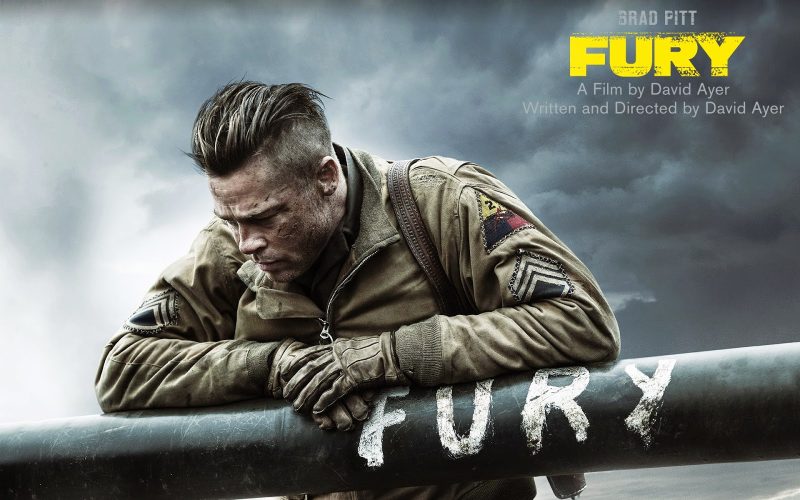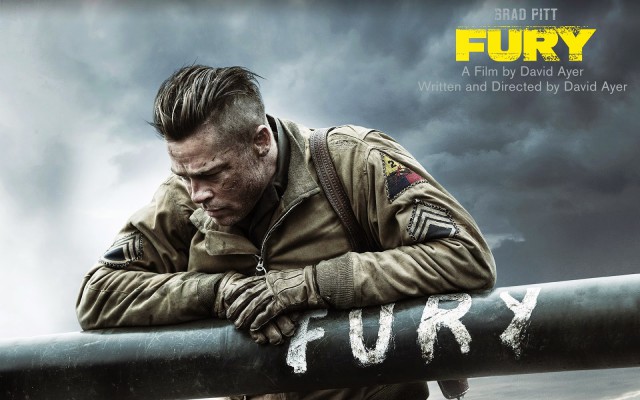Cast your weary minds back to the summer of 2013. I was sitting with a colleague in the press office at the War & Peace Revival when a gentleman informed a show official he was a producer on a new war movie. My mate and I sat listening to the conversation about acquiring vehicles and went away sniggering because this guy seemed to be the embodiment of a caricature movie type. I even took flak for a description I posted on a forum of the scene even though I had witnesses. I went away and checked with my colleague who confirmed what we had seen and heard. I stick by my recollections.
Then the news started to filter in that there was, indeed, to be a new movie and Brad Pitt was in it. It was apparent that production of the film would be something of an event on the UK military scene. Cut away to months ago and the new story was that the Tank Museum had loaned the historic Tiger 131 to the filmmakers for a tidy sum. I suppose the impact of this news was something like – wow! Time marched on and the paparazzi hovered around the movie set and came away with unimpressively distant snaps of Brad and various bits of hardware. Meanwhile the publicity machine for the film ran a measured campaign. I don’t think things ever reached a level of what I would call hype, but expectations in our military world were high.
Back in June I had a chat with a mate who had some kit used in the film and he was ambivalent about the whole experience. By contrast Facebook offered a smattering of posts from other acquaintances, living historians or re-enactors who had been extras and they were all enthusiastic. Another year, another W&PR where the Cromptons displayed two Alvis Stormers modified with the upper works of a Tiger and a Sherman for film work. I sensed a mixed response to them but my only disappointment was not to see them running.
After all this, the eagerly awaited Fury is finally on release in the UK and I rushed off to my local Odeon with my son to see whether the end result is worth all the anticipation. The short answer being – it is!
Reviewing war films can be, forgive me, a minefield. On the one hand the viewer is taking in the plot and the performances and on the other they are looking at the details. Let’s deal with the latter first. All the kit and people look just right to me. Everyone looked dirty and tired and far from parade ground perfect. There was a proper mix of personal weapons and equipment and all the background artists were authentic. The tanks and vehicles looked fantastic.
The performances were impressive. A first rate leading and supporting cast were on the button. The plot intrigued me. There is no question in my mind that it does draw parallels with Saving Private Ryan. The story of a young army clerk, Norman, being thrust in to the horrors of combat and having to deal with his own frailties mirrors the role of the Upham character in SPR. As with Upham, our guy goes through a number of crises on his way to a kind of redemption. The remainder of the tank crew are at times terrifying, philosophical or funny. Another film which surely had an impact on David Ayer’s thinking is the rarely seen The Victors from 1963, a film which explores many of the themes seen here.
The Brad Pitt character, Wardaddy, tells us “Ideals are peaceful, history is violent. “ He isn’t far wrong. To me the film highlights a huge sense of loss, not just in lives but in something much deeper and personal; the sense of proportion we have is smashed by war and we become distorted. All the veterans in Fury are haunted by violence and struggle with their emotions. By the time of the film’s setting, April 1945, they have experienced far too much and are damaged goods. Call me daft but the unspoken background to the story, the men growing up during the Great Depression with all its hardships, is evident. The running joke – best job I ever had – can be cast to cover so many eventualities. On balance the grim reality of war and what it does is all here. So perhaps the ultimate point is that all the leading characters find some kind of redemption in their own way.
The famous Tiger makes an appearance in a dramatic scene and the general use of the tanks with all the homely or claustrophobic atmosphere for the crews you can choose to interpret are there. Tracer flies everywhere and the violence is at times grim but never over the top. I didn’t see any comedy Germans, you know the type; more common in war films before the ground breaking SPR. The appearance of African-American combat troops fits correctly into the setting post the Bulge when more of these men were arriving in theatre. All these details made for a safe canvas for the drama to be painted on.
My son and I came out of the cinema agreeing we must see the film again. It was so refreshing after the dismal Monuments Men. So I am pleased to report that the wait for this film has been worth it. The plot was nothing I expected and the acting was top drawer. Movies are meant to entertain first and foremost and this one definitely does that. I hope it garners the same affection bordering on cult status SPR enjoys. The plot does have many similarities with the Spielberg epic but they are very different animals. Choosing between them is impossible. In their own ways both films explore a darkness but always come out into the light.
A friend of mine with no interest in military matters ran a professional eye over War History Online and said, it’s good because there is such a lack of Brad or George [Clooney]. Bad timing aside…. Maybe so, but while George blew it; Brad has brought home the bacon and he can show his face around here whenever he likes.
Reviewed by Mark Barnes for War History Online
FURY
134 mins
Written and directed by David Ayer
On general release.

